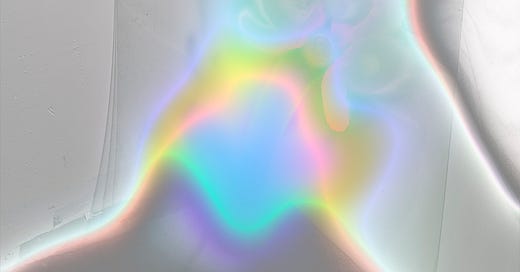Adrienne’s approach is just to listen. She used to do a practice of deep listening, a kind of meditation in which she would close her eyes and just track what she heard. It cleared her mind of other thoughts and helped her train herself to pay attention, to keep focused. It’s about getting more attuned to that particular part of your brain and being able to more easily receive what it has to share.
Doing massage and energy work, and now as a psychotherapist, she’s been developing her intuition for decades—reading people, seeing the patterns in how they present and compose themselves, the subtleties of their embodiment. She thinks each of us is like a chord, resonating with other chords. And that’s information. Just a nervous system picking up on whether other nervous systems are regulated or dysregulated. Something she got good at, partly, in childhood. With our mom having a mental illness, it was the way that she could understand her. With our dad, it was when she felt something going on in him that he was not acknowledging, and she needed to know how close or far away to be. It was confusing because it was incongruent with his idea of what was happening, but she trusted what she felt.
And that’s a survival skill that a lot of kids get, she says. Probably a number of children of trauma will say, Yeah, I learned how to read people, to stay safe. A lot of information comes through just reading people that way. And she thinks it can be backed by actual—if you could pause the scene and really pick apart what just happened there, she thinks intuition goes off of very real cues. Sometimes there’s projecting, but at this point she kind of trusts that her intuition isn’t just projections.
So being at her table with a client has become a space of listening. It’s quiet, and peaceful, and there she can tap in—listen to her own body, her own ear—because the flashes don’t come by way of others’ senses, only through her own. It seems to her that her brain is built to interpret this information in a certain way. It comes through and takes a shape that seems intended for the client, seems designed so that they will understand its meaning even if she does not.

Like the time she was doing massage on a woman and kept seeing—well, it felt like an Irish spring. There was greenery and moss, a verdant and dew-covered place, and misty clear air and a little babbling brook. And she felt a light, bubbly effervescence, a lifting up, or being lifted. In her body it was as if there were bubbles streaming through her blood, pulling up her shoulders. And at the same time she kept hearing the words Irish Spring. Like the soap, yes. So she told this to the woman on the table, and laughed and said, Like those old commercials! But the client didn’t know how that related to herself, couldn’t think of any connection she had to Ireland. So Adrienne reflected, and she sensed kind of a female energy so she said, Is there a grandmother? And the client perked up and said her grandmother was from Finland and was born on St. Patrick’s Day.
In New Age terms, you would take this to mean that the client’s grandmother is there in the room with you, and you would let them know that. And maybe this one was a stretch, and kind of funny and weird. But in moments like that it really feels to her like the pieces are falling together and there’s a sense to the whole thing. Still, she can’t speak definitively, really, about believing or disbelieving such things. She holds the tension of two opposites: that it’s possible, but maybe not true. And in truth, she doesn’t feel the need to know, to really tear it apart and analyze it. Because it’s so personal anyway. At least, that’s how she sees it. It’s in the realm of the imaginal, or dream, or play.



